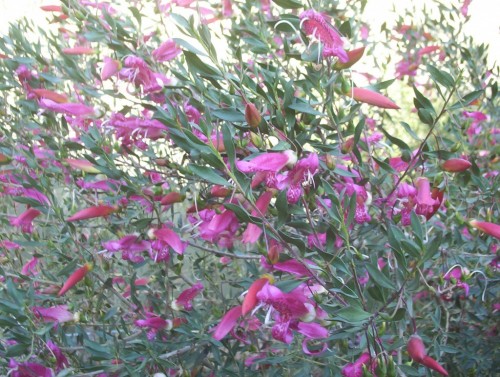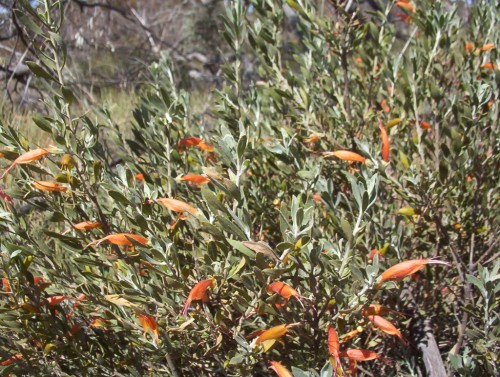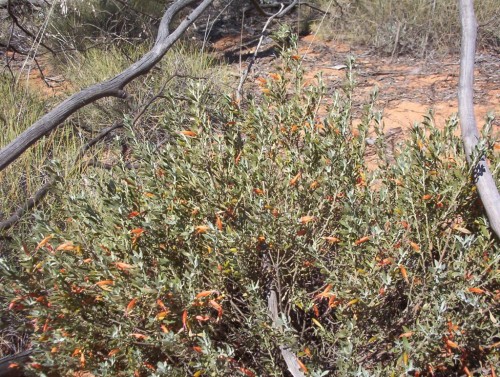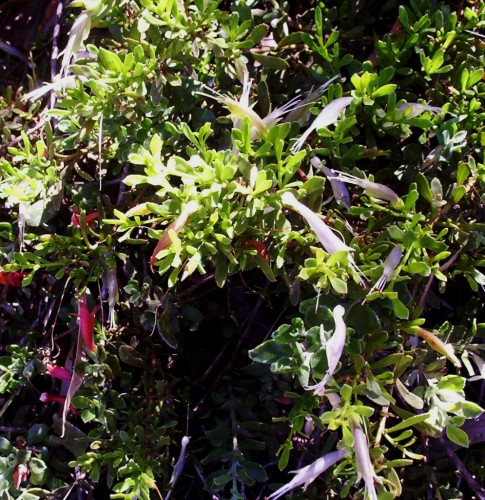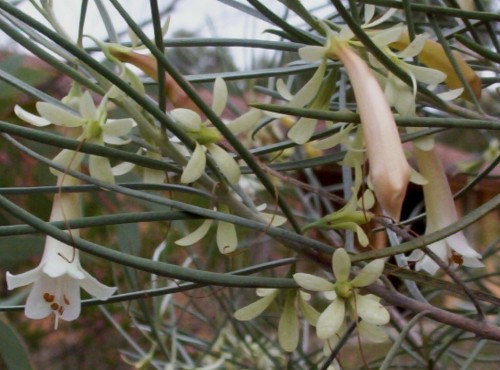Eremophila maculata forms (Emu Bush)
The Eremophila Study Group News Letter arrived and we are being encouraged to spread the good word about Eremophilas as hardy plants.
Plant hardiness is a relative term, I think. On the gardening programme Gardening Australia on ABC TV, the term is used by presenters in the Eastern States. A plant is described as hardy there, when I know that it is not hardy here unless it is regularly watered during the summer. A writer in the ‘Journal’, magazine of the Australian Plants Society, South Australia, prefers to refer to plants as being ‘adaptable’ or not. I tend to agree with him. There are many plants which would come into that category.
However, Eremophilas tend to be both hardy and adaptable. The issue that bothers many plants is over watering. Especially plants in pots. Watering regularly on a weekly basis as our water restrictions impose on us will spell disaster for many native plants, especially those that have a form of summer dormancy. Another issue is drainage which must be very good for Eremophilas.
The photo above is a selection of Eremophila maculata ‘Wendy’ which has reddish buds which open to dark pink. Tip pruning and trimming produces a bushy plant and many flowers.
Eremophila glabra orange form (Emu Bushes)
We were driving along the Konardin track near Hattah-Kulkyne National Park and came across this lovely orange flowered Eremophila glabra.
Eremophilas are such drought hardy plants that they are proving to be very popular with gardeners at the moment. Drought has taken its toll on many otherwise hardy plants. Generally speaking Eremophilas are arid land plants. Surprisingly most like quite heavy soils but also prefer good drainage. Trimming after flowering from the very beginning maintains the foliage near the trunk and branches. Many Eremophilas become very woody without this. Some species can be cut back very hard to bare wood and they will sprout new growth.
It seems to be a problem in wetter areas to grow these plants. Raised beds may be the answer and also open areas with good air movement.
New Eremophila Book
The post brought my new reference book on Eremophilas. This book by Bob Chinnock is a very new publication and people have been waiting for years for its arrival. There has been great interest in eremophilas because of their drought hardiness. Many have been described in other publications but some name changes have occurred and a number of sub species identified. Also included in the book is the related species Myoporum.
The book is calledÂ
Eremophila and allied genera, written by RJ Chinnock. Published in Australia by Rosenburg Publishing Pty Ltd.
Mine is a pre publication copy. The official publication date is 24th April 2007.
The blurb on the cover says it has taken 30 years of research to produce this book. I am looking forward to studying it. It is a very large book and some what technical but it is the descriptions that I am most looking forward to using.
Eremophila veneta (metallica) and Birds
Eremophila veneta is a hardy ground covering plant with silver and green flowers. It grows to about 15-30cm tall by 1-1.5m wide. It thrives in a dry, hot position with good drainage.
I am sure that the Shingle Back Lizards find the water in the bird bath which is on the ground in the same way. I have watched them walk quite a distance in a very purposeful manner, heading in a direct line for the dish.
More information can be found here.
Drought Proofing Our Gardens 2
How can people live without water? How can people live without green plants around them? Who is it who thinks that people will actually be living if all gardens are left to die around them? How can anyone isolate people from plants? How come, when irrigation allocations are reduced, there is still adequate production? Why are these huge allocations made in the first place to individuals or companies to the detriment of an ecosystem which benefits all citizens? Why are those who use their water in a responsible way treated in the same way as wasteful individuals and businesses? Why is there so little education about the actual amount of water required by plants, the best cost effective way to water, to set up sprinklers or drippers effectively, to use timer taps, to improve soil moisture retention, etc?
In spite of the fact that I feel extremely annoyed, I look at a plant like an Eremophila (emu bush) knowing that the gorgeous flowers celebrate a plant that is drought hardy. It is useful as a feature plant or hedge or screen. Also, so long as it has good drainage and is trimmed occasionally as emus or kangaroos would do it, it will provide pleasure in the garden for many years. There are so many useful Australian native plants like this.
I will get over the feeling of helplessness I have one of these days. I just have to do my bit where I am and hope that lots of individuals like me are doing the best that they can also.
The Eremophila shown is a beauty in that it comes in shades of cream, pink, lilac and ruby and probably some others I don’t know also. It is a mallee plant. That is it grows in mallee woodland areas. I like the calyx which is left after the flower has finished, giving the plant the appearance of another flowering.
